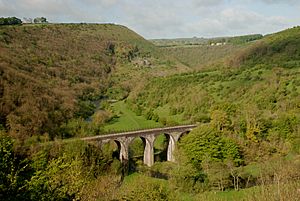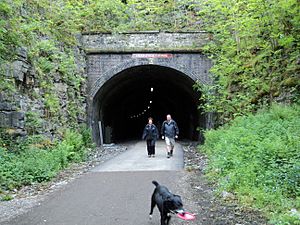Monsal Dale facts for kids
Monsal Dale is a beautiful valley found in Derbyshire, England. It's located within the Peak District National Park, a special area known for its stunning nature. The valley is part of the White Peak region, which has lots of limestone rock.
Monsal Dale is so important that it has several special protections. It's a Site of Special Scientific Interest (SSSI), which means it's a top spot for wildlife and geology. It's also a Special Area of Conservation (SAC), protecting its natural habitats. These protections are part of a bigger European network called Natura 2000, which helps keep important natural places safe across Europe.
Contents
Headstone Viaduct: A Historic Bridge
The Headstone Viaduct is a famous bridge that crosses the River Wye in Monsal Dale. It was built a long time ago, in 1863, by the Midland Railway company. This company used to run trains across the country.
The viaduct is about 91 meters (300 feet) long. It has five big arches, each about 15 meters (50 feet) wide. Some parts of the bridge stand as high as 21 meters (70 feet) above the ground. When it was first built, there were some small problems with the ground moving. Workers fixed these issues between 1907 and 1908.
A Bridge of Beauty or a Scar on Nature?
Today, many people think the Headstone Viaduct looks very elegant. It was even given a special status in 1970, called Grade II listed. This means it's an important historic building that should be protected.
However, when the viaduct was first built, not everyone liked it. A famous writer and critic named John Ruskin was very upset. He believed the railway was ruining the natural beauty of the valley. He wrote that the valley was once "divine" (like a heavenly place). He felt that building the railway, blasting rocks, and filling the stream with waste destroyed its beauty.
Ruskin's main point was that while the railway made travel faster, it came at a great cost to nature. He thought people were foolish to trade the valley's beauty for quick trips between towns like Buxton and Bakewell.
There was even a plan for another huge viaduct to be built nearby. This second bridge would have been for a different railway company, the Lancashire, Derbyshire and East Coast Railway. It would have crossed both the valley and the existing Midland Line, standing about 91 meters (300 feet) high. Luckily for the valley, this plan never happened.
Monsal Trail: A Path for Everyone
The Headstone Viaduct is now part of the Monsal Trail. This trail is a popular path for walking, cycling, and horse riding. It follows the route of the old railway line.
Headstone Tunnel and Other Tunnels
At the southern end of the viaduct is the Headstone Tunnel. This tunnel, along with two others called Cressbrook and Litton Tunnels, was reopened to the public in May 2011. This means people can now walk or cycle through these old railway tunnels.
Monsal Dale Railway Station
There used to be a railway station in Monsal Dale. It opened in 1866 to serve the nearby villages of Upperdale and Cressbrook. Cressbrook was known for its cotton mills, so the station helped people and goods get to and from the mills.
The station was built in an interesting way. The track for trains going one way was carved into the rock face. The track for trains going the other way was built on wooden supports over the hillside. The station closed in 1959, and today, none of the old wooden buildings remain.
From Monsal Dale, the railway line continued through two more tunnels: Cressbrook Tunnel (431 meters or 471 yards long) and Litton Tunnel (471 meters or 515 yards long). These tunnels led to Millers Dale further north. They were difficult to build because they were cut through solid limestone. They also had a slight slope and curved shape to follow the natural landscape.




